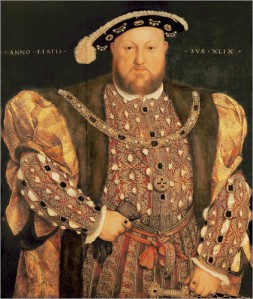PINKY SAYS: THE HERITAGE OF HENRY THE VIII
If cocktail conversation ever veers toward marriage or the Tudors or Henry the VIII there are stock replies that suggest that he was far too fat and was exceedingly troubled with getting rid of his various wives. Hilary Mantel portrays him as despotic and desperate to produce a male heir in her prize winning novel Bring Up the Bodies. We know him as the corpulent king who becomes increasingly blood thirsty. However, although we are justified in this assessment of Henry, certain good and interesting points are sacrificed and should be considered. When Henry was not hunting or waging war, he was a rabid collector of art and tapestries, and though his purpose in art gathering was to focus on the power of the English throne he did collect wonderful objects.
This majesty of the Tudor Court was part of a concerted campaign by Henry to put the country and his dynasty on the map. He acquired displays of armor, textiles, portraits and silverware to boost his reputation. At the time of his accession to the throne in 1509 England was at best a marginal nation on the edge of Europe and Henry wanted a prominent place on the map of the continent. The entire campaign was for the purpose of self aggrandizement. He set about building palaces to house his huge collections of furnishings as well as the royal crown jewels. There were 17,000 items in the collection at the time of his death in 1547. Henry’s amassed wealth of objects made greater claims to the power of England than could really be justified at the time. His idea was that international visitors would see his lavish court full of wonderful tapestries and deduce that if he could afford to spend that much on a simple wall hanging there would be no limit to what he could spend on ships for war.
And so by the time of his death Henry had about 55 palaces inducing Nonesuch, St.James and Whitehall. The most spectacular of his palaces was Hampton Court which he forced Cardinal Wolsey to surrender to him. Hr then rebuilt and extended the palace, spending the equivalent of $18 million today. At its completion Hampton Court was the most modern and magnificent palace in England. There were tennis courts, bowling alleys, and 60 acres of formal gardens. The kitchens covered 36,000 square feet. The Great Hall took five years to complete and Henry was so besotted with it that he had his masons work through the nights by candlelight to finish it. There were tapestries stitched with real gold ad silver thread, the floors tiled in the Tudor colors of green and white. Persian rugs and portraits added to the opulence as did crystal clocks and ornate carved furniture. Expensive wax candles were imported from Venice. And for what purpose? Henry became in the eyes of his neighbors a true Renaissance king. He was a skilled jouster, diplomat, lawmaker, patron of the arts, builder and musician. He even had running water for his bath. Water was channeled from a hill 2 miles away. As it traveled down it built up pressure which meant it could then be forced up a lead pipe and out of a tap into the bath. The tub was round and carved of wood lined with a cloth to prevent splinters.
Henry imported the artist Hans Holbein to become the official court painter to the king. Holbein was considered to be the greatest painter of the period. It is possible that this may have been the reason that England did not produce native artists of distinction until many years later. They encouraged great artists from other nations to paint for them. They did celebrate the written word and English philosophers were among the leading intellectuals of the time. It just seems that visual images were either too difficult for them or they valued the visual beauty of the actual England and its people and felt that the real thing was more perfect and yes, priceless, than any simulation of it could be.
There were almost 2500 tapestries in Henry’s inventory as well as huge quantities of rugs imported from Persia and Turkey. Only Henry could walk on them. One series of 8 tapestries depicted the story of Abraham who sired a son at the age of 99, thus suggesting that Henry too would be capable of siring a male heir. He demanded that heraldic carvings and motifs be added wherever possible to remind people that his favorite wife, Jane Seymour, belonged to one of the most important families in England. He was also trying to make people forget about his own slightly shaky royal lineage. For Henry did not come from a long line of kings and he knew that he had to constantly remind his subjects and the nations of Europe of his great power and cultured court. So while the people became more secure with their sovereign Henry achieved his goal to make England an important presence in Europe. Maybe Henry VIII was not too different from powerful collectors of today whose acquisition of art is perhaps guided by a desire for prominence or power.



Leave a Reply